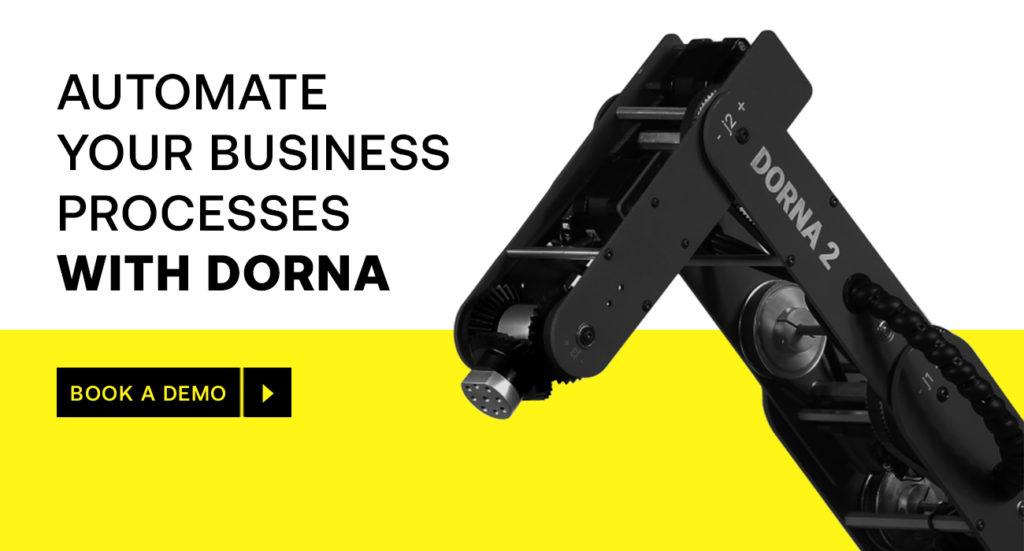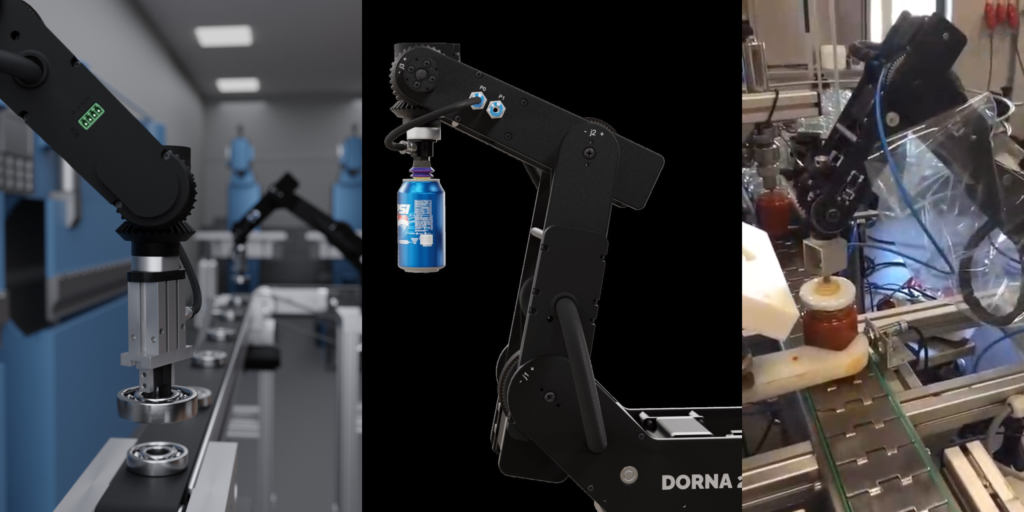Blogs
Pick and Place Robot: A Comprehensive Guide
This blog aims to explore the essence of pick and place robots, providing a comprehensive understanding of their components, operational…
30 minute read
In This Article
Warehouses are the logistical backbone of innumerable industries as they facilitate the storage and movement of goods at various stages of the supply chain. Today, however, traditional warehouses are grappling with the multifaceted challenges of a fast-paced and continuously evolving world.
With the surge in e-commerce, there has been an intensified need for rapid order fulfillment, increased storage capacity, and greater inventory accuracy. Warehouses must also contend with labor shortages, rising operational costs, poor worker safety, and the imperative to embrace sustainable practices.
To address these issues, many businesses are turning to material handling automation to optimize their processes and strengthen their competitiveness.
Dorna is a leading provider of robotic arms efficient for material handling applications. Their sturdy design and compact size, combined with easy training and unexampled efficiency have made them a recognized and trusted automation partner.
The following article lays down the advantages and effective techniques of material handling automation to help businesses enhance their industrial processes. But first, it is important to grasp what exactly is material handling.
Material handling is the process of moving, controlling, and managing materials within a facility or a supply chain. It involves the transportation, storage, and manipulation of goods, products, or raw materials to ensure they are in the right place at the right time to meet operational and customer demands.
Material handling is employed across industries but is typically utilized in warehousing, where goods need to be securely stored, retrieved, and shipped.
A material handling system can range from simple manual handling, like lifting and carrying, to highly automated systems involving conveyor belts, robotic arms, and other machinery known as material handling equipment.
Automated Material Handling Systems (AMHS) are advanced technological solutions designed to automate the movement, storage, and retrieval of materials or products at any particular site, such as a warehouse, distribution center, or manufacturing plant.
These systems replace or augment manual labor with automated processes and machinery to improve operational efficiency, accuracy, and productivity.
Various kinds of automation devices are used today to automate and optimize different parts of the material handling process of warehouses. These are:

Researchers at the Material Handling Institute have authored a document outlining the ten fundamental principles of material handling, aiming to establish safer and more efficient material handling systems. These are:
Strategic Planning
Formulate a well-defined plan for your material handling system, specifying the materials to be moved, the equipment to be employed, and the storage locations to be used.
Standardization
Standardize processes and equipment to achieve predictable outcomes while allowing for adaptability.
For instance, when dealing with uniform-sized boxes, anticipate potential size variations, ensuring equipment compatibility with varying box dimensions.
Efficiency Enhancement
Reduce extra labor by utilizing equipment to minimize or eliminate repetitive tasks.
Ergonomics
Prioritize employee well-being by investing in ergonomic equipment, ensuring a safe working environment.
Unit load Utilization
Maximize efficiency by using unit loads like containers and pallets, minimizing effort and reducing walking time within the warehouse.
Space Optimization
Organize your warehouse to effectively utilize the space by decluttering aisles, utilizing vertical storage, and categorizing products efficiently.
System Integration
Incorporate tracking tools to swiftly identify materials and products at every phase of the system.
Environmental Responsibility
Opt for equipment that curbs energy consumption and curtails greenhouse gas emissions.
For instance, opting for an electric forklift over a liquid-propane-powered truck demonstrates a more sustainable approach.
Automation Integration
Integrate automation into warehouse processes, particularly in picking and retrieval, to drive down costs and enhance employee productivity.
Life Cycle Cost Analysis
Conduct a comprehensive life cycle cost analysis of material handling equipment, taking into account factors such as programming, installation, setup, operation, repair, maintenance, reuse value, and disposal to ensure durability and sustainability.
Material handling automation offers a myriad of benefits for businesses in various industries.
It carries the potential to completely transform a business by fostering a more efficient, cost-effective, and competitive environment while prioritizing employee safety and environmental responsibility.
Naturally then, material handling automation differs significantly from manual material handling systems in more than one aspect. Here’s a breakdown of the key differences between these two approaches to material handling:
| Factors | Manual Material Handling | Automated Material Handling |
|---|---|---|
| Labor involvement | Relies on physical human labor for tasks like lifting, carrying, and transporting materials. | Uses machines, conveyors, robotics, and other technologies to replace or assist human labor. |
| Precision | Human workers may naturally vary in their precision and efficiency potentially leading to errors, delays, and inconsistencies. | Automation systems operate with high precision, ensuring consistent and accurate material handling. They follow programmed instructions and do not tire, resulting in minimal errors. |
| Speed and throughput | Manual processes are often slower compared to automation, which can lead to longer lead times and reduced throughput. | Automation systems work at a consistent pace, allowing for faster material handling, higher throughput, and more efficient operations. |
| Labor costs | Labor costs are a significant component of the expenses, as they involve wages, benefits, and training. | While the initial investment in automation can be substantial, it reduces long-term labor costs and reliance on manual workers. |
| Safety | Manual handling can involve physically demanding and potentially hazardous tasks, which can pose a high risk of injuries and accidents to workers. | Automation enhances workers’ safety by reducing the need for them to perform physically strenuous or dangerous tasks. |
| Adaptability | Manual processes may offer flexibility in handling a wide range of materials but require time and skilled workers to adapt. | Automated systems can be programmed and configured to adapt to multiple tasks quickly, making them flexible and versatile in handling different materials. |
| Scalability | Scaling manual operations often requires additional labor, which can be challenging to manage. | Automation systems can be easily scaled up or down to accommodate changing business needs, making them highly adaptable and useful. |

Material handling plays a pivotal role in ensuring the secure and efficient transportation of materials and products across various stages of the supply chain, spanning from manufacturing to distribution. These are the different ways it is implemented:

An effective material management system extends beyond the simple movement of goods. It provides your warehouse operations with a standardized process for handling and transporting materials from start to finish.
At Dorna, our automated solutions are designed to integrate into each stage of the supply chain and help you ensure your material handling operations flow smoothly, and more efficiently, creating a streamlined supply chain.
Take your material handling to the next level!
Blogs
This blog aims to explore the essence of pick and place robots, providing a comprehensive understanding of their components, operational…
30 minute read
Blogs, Products
Dorna, a leading name in robotics, has taken the stage with its state-of-the-art 5-axis robot arms. These innovative machines are…
22 minute read
Blogs
The gripper is an end-of-arm tool that makes a robotic arm versatile and efficient for different processes like pick and…
27 minute read
Blogs, Products
Robotic arms are masters of manipulation, and their prowess lies in the intricate principles governing their operation. These principles play…
35 minute read